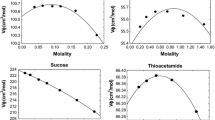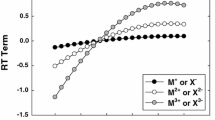Abstract
The dissociation constant of morpholinium ion has been determined in five synthetic seawaters at eight temperatures from 5 to 40°C. The seawater solvents contained NaCl, MgCl2, Na2SO4, CaCl2, and KCl in amounts corresponding to salinities of approximately 10, 20, 30, 35, and 40‰ (parts per thousand) and ionic strengths ranging from 0.2 to 0.8 mol-kg−1. Electromotive-force measurements of cells without liquid junction, with hydrogen gas electrodes and Ag/AgCl electrodes, were used to derive the dissociation constant and associated changes of enthalpy, entropy, and heat capacity for the dissociation equilibrium. The pK values over the range of salinity S and thermodynamic temperature T studied are given by the equation
At a salinity of 35‰, corresponding to ‘normal seawater’, pK is higher by 0.206 at 25°C than in the water solvent, while ΔHo is increased by 292 cal-mol−1 and both ΔSo and ΔC p o are substantially unchanged. The buffer composed of 0.04 molal morpholinium chloride and 0.04 molal morpholine is useful for pH control in synthetic seawater media.
Similar content being viewed by others
References
K. H. Khoo, R. W. Ramette, C. H. Culberson, and R. G. Bates,Anal. Chem. 49, 29 (1977).
R. G. Bates and C. H. Culberson, inThe Fate of Fossil Fuel CO 2 in the Oceans, N. R. Andersen and A. Malahoff, eds. (Plenum Press, New York, 1977), p. 45.
K. H. Khoo, C. H. Culberson, and R. G. Bates,J. Solution Chem. 6, 281 (1977).
R. W. Ramette, C. H. Culberson, and R. G. Bates,Anal. Chem. 49, 867 (1977).
R. G. Bates and J. G. Calais,J. Solution Chem. 10, 269 (1981).
W. R. Erickson, M. S. Thesis, University of Florida, 1980.
H. B. Hetzer, R. G. Bates, and R. A. Robinson,J. Phys. Chem. 70, 2869 (1966).
J. Czerminski, A. G. Dickson, and R. G. Bates, unpublished work.
A. G. Dickson and J. P. Riley,Mar. Chem. 7, 89 (1979).
D. R. Kester and R. M. Pytkowicz,Geochim. Cosmochim. Acta 34, 1039 (1970).
R. G. Bates,Determination of pH, Theory and Practice, 2nd ed. (John Wiley & Sons, Inc., New York, 1973), Chap. 10.
R. A. Robinson,J. Mar. Biol. Assoc. U.K. 33, 449 (1954).
R. G. Bates and J. B. Macaskill,Pure Appl. Chem. 50, 1701 (1978).
R. G. Bates and V. E. Bower,J. Res. Natl. Bur. Stand. 53, 283 (1954).
D. J. G. Ives and P. G. N. Moseley,J. Chem. Soc., Faraday Trans. I 72, 1132 (1976).
Author information
Authors and Affiliations
Additional information
On leave 1980–1981 from the University of Gdańsk, Poland.
Rights and permissions
About this article
Cite this article
Czerminski, J.B., Dickson, A.G. & Bates, R.G. Thermodynamics of the dissociation of morpholinium ion in seawater from 5 to 40°C. J Solution Chem 11, 79–89 (1982). https://doi.org/10.1007/BF01036376
Received:
Revised:
Issue Date:
DOI: https://doi.org/10.1007/BF01036376




